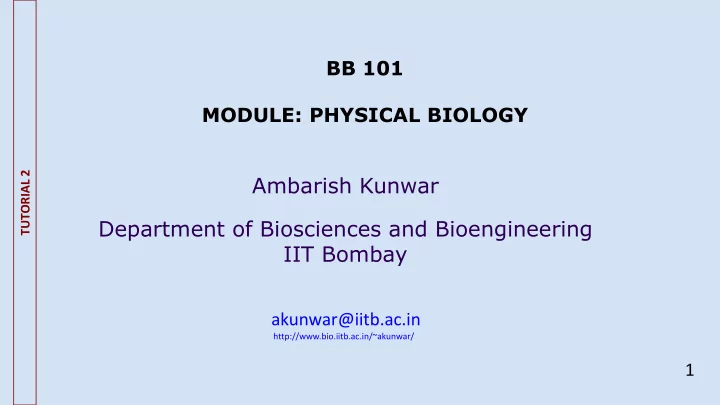

BB 101 MODULE: PHYSICAL BIOLOGY TUTORIAL 2 Ambarish Kunwar Department of Biosciences and Bioengineering IIT Bombay akunwar@iitb.ac.in http://www.bio.iitb.ac.in/~akunwar/ 1
1. Consider a microscopic swimmer trying to make progress by cycling between the upward and downward strokes of its paddles as shown in the figure below (a) On the first stroke, the paddle move downward at relative speed v, propelling the body through the fluid upward at speed u. (b) On the second stroke, the paddle move upward at relative speed v’, propelling the body downward at a speed u’ (c) Then the cycle repeats. Assume this is low Reynold’s number motion where moving the body through the fluid requires a force determined by drag coefficient 1 and moving the paddles through the fluid requires a force determined by a different constant 2 . Show that reciprocal motion like this cannot give net progress in low Reynold’s number environment. 2
2. Bacterial use flagella motor to rotate the helical flagellum to generate the propulsive force. Provide a qualitative explanation (using the result from Problem 4 of Tutorial 1) that if a thin, rigid helical rod as shown in figure below is cranked about its helix axis at a certain angular speed then it can generate a net force propulsive force. 3
3. The aim of this problem is to show that a random walk leads to diffusive behavior. Suppose there is a drunkard person, as shown in the figure below, walking along a line such that he takes steps of L, either to the left or right, with equal probability. So that his position x N after taking N such random steps is given by , where <> denotes average over number of all possible way in which drunkard person can take steps. 4 Figure Source: Biological Physics, Philip Nelson (Publisher: W. H. Freeman)
5 Figure Source: Biological Physics, Philip Nelson (Publisher: W. H. Freeman)
Recommend
More recommend